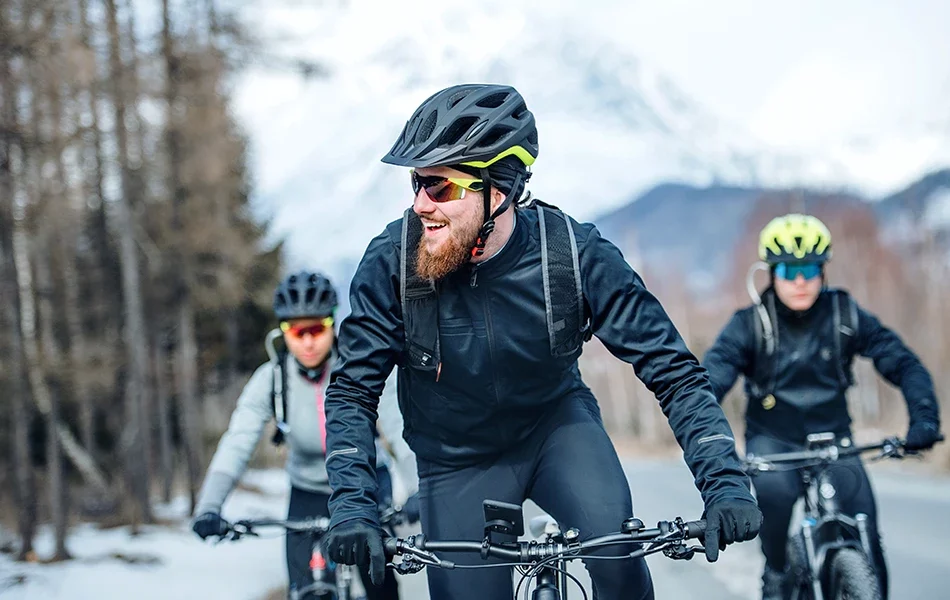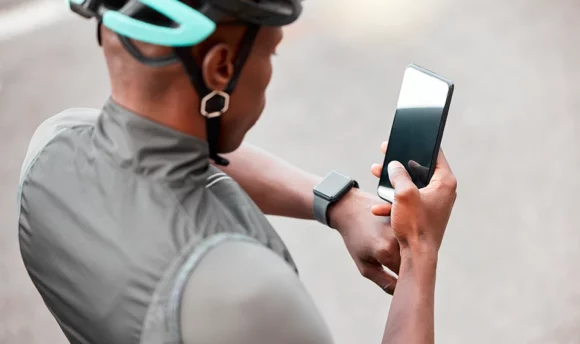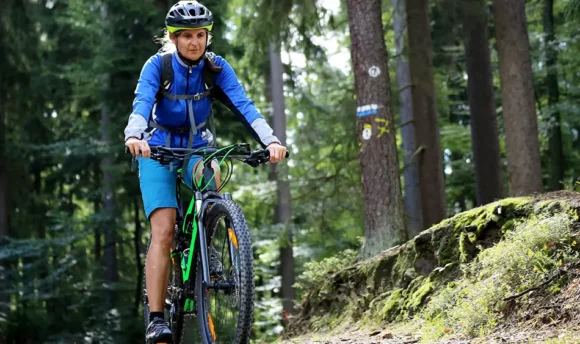10 Tips for Riding a Bike in Winter

If you fancy a challenge this winter, consider winter biking.
Winter cycling is a fantastic sport to keep active when the colder weather hits. There are countless health benefits to be had, from strengthening your heart and lungs to boosting your mood during the darker days.
If you’re already a cyclist, you might think it’s time to put your bike away as the temperatures drop, but this couldn’t be farther from the truth. Beginners and pro cyclists can make the most of the season with winter biking.
It’s a bit riskier than other forms of cycling, so before you head out on your winter bike ride, consider these top 10 tips.
Why Should You Try Riding a Bike in Winter?
Riding a bike in winter helps you stay active year-round. Many people avoid outdoor activities when the temperature shifts, but cycling is a sport you can perform anytime. It may have even more health benefits in the cold since it poses more of a challenge.
When cycling in a colder climate, the heart and lungs must work harder to maintain your core body temperature. This not only enhances your cardiovascular fitness but increases calorie burn, making winter riding one of the best cardio exercises for weight loss.
And according to research, any form of cycling is linked to decreased cardiovascular disease risk.
Furthermore, winter cycling offers a powerful mental wellness boost. People with seasonal affective disorder (SAD) experience depression during a particular season, but studies show that engaging in physical activity can help counter seasonal depressive disorders.
Now that you’re ready to try cycling in winter, there are a few things you need to know. Here are some top tips to keep you comfortable, safe, and striving toward your winter cycling goals.
#1 Choose the right clothing
Comfort is key for biking in winter. Wearing the proper cycling clothing will make your ride more enjoyable as cycling gear is designed with a purpose – to keep you comfortable, warm, or cool and at less risk from injury. It also reduces aerodynamic drag so you can cycle faster.
In winter conditions, wearing clothes that stop you from getting too cold is essential. Start with base layers that warm your core and build up from there. A good outer layer will ensure you stay warm and dry, so choose waterproof, breathable, and moisture-wicking fabric.
Don’t forget to wear bike gloves to keep your hands warm. Cold hands can make winter riding a misery. Your feet are another extremity that will feel the cold more quickly, as they miss out on blood flow when your core body temperature drops.
A quality pair of thick socks will keep your toes toasty. Winter cyclists tend to wear slightly larger shoes to accommodate thicker socks, so keep this in mind when selecting footwear.
#2 Make yourself visible
There are fewer hours of sunlight during winter, making visibility on your bike even more critical. Consider the same riding tactics you’d use when cycling at night. Safety lights (including front and rear lights) and wearing reflective gear will ensure you cycle safely.
#3 Warm up before riding
Winter riders need to warm up properly before they start cycling at speed. Doing so helps prepare the mind and body for optimal performance. Although a low-impact activity, cycling targets several muscle groups, and warming them can help prevent common cycling injuries.
#4 Reduce your tire pressure
Winter cycling requires low tire pressure to provide better road grip in wet and slippery conditions. Don’t deflate them too much – they should be in the mid to low range.
Check your tires before every winter ride, as tires lose air faster than normal. If winter cycling is going to be a long-term thing, you may want to invest in wider tires that give you more traction. Knobby or studded bike tires are perfect for riding on ice and snow.
#5 Take up the lane
In the winter, sleet, snow, and general debris tend to cover the bike lanes, especially along the curbs. This makes it difficult to ride in your usual spot. If that’s the case, you can move to the middle of the road and use the bike lane when necessary.
At the same time, you should ride defensively. This means staying alert and preparing for the unexpected. Drivers don’t expect to see cyclists in the cold, so they may not look out for you. Make yourself as visible as possible to avoid accidents.
#6 Watch your energy levels
You need plenty of energy to fuel your ride and maintain performance from the get-go. Focusing on what you eat before cycling is essential practice to ensure your mind and body have what they need to power through.
Stocking up on carbs and protein works for most people. Energy bars, fruit, peanut butter, eggs, and poultry are some excellent energy-boosting foods. You can also drink caffeinated beverages, like coffee and tea, to naturally enhance your physical and mental performance.
Depending on the duration, eating beforehand might not be enough to keep your energy levels up. Be sure to pack snacks to eat on the road when you feel hungry and tired. Stick with healthy and nutritious choices to reap the benefits of burning calories through cycling.
#7 Plan your route
Because you’re likely to face more challenges in the winter, it’s important to plan your route wisely. You can check bike trails and weather conditions at specific locations. Knowing an alternate route or calmer roads where you can ride more safely is always a good backup plan.
It’s also important to consider the distance you’ll be cycling. Often, whether it’s too cold to ride depends on how far you’re going. If you’re going on a long ride, remember that you can take public transport and use bike racks if you need a break or to warm up.
#8 Carry necessary supplies
Carrying supplies will ensure that you don’t get into a tricky or dangerous situation. Always carry extra batteries for your lights, water in an insulated bottle to keep it from freezing, and a snack or two to keep you going in case you miss meals.
A spare pair of gloves and Merino wool socks are also a good idea, especially if you accidentally get your hands and feet wet during the ride. You can evenly distribute the extra gear in panniers to make sure your bike can handle the extra weight.
#9 Be cautious
No matter the season, you need to stay alert on the road. However, winter cycling can be more dangerous due to weather conditions. For example, the sun can melt snow during the day, creating black ice when it refreezes. Watch out for sunny spots where the road has been exposed to the winter sun, and be careful to ride slowly.
It’s also the time of year when darkness creeps in earlier, so be careful when riding in areas without street lights.
To be prepared in case of an emergency, many cyclists carry a first aid kit with them. You never know when you might need to bandage a cut or abrasion from an unexpected fall.
#10 Take care of your bike
Taking care of your bike will help it take care of you. Maintenance is essential to keeping your winter bike in top condition while you expose it to the elements.
Clean the entire bike, including all parts, from top to bottom. Cleaning is essential, especially if you ride regularly and go on snowy or dirty rides.
You’ll also need to lubricate the drivetrain and check the tires and brakes. A general rule of thumb is to have your bike professionally serviced once a year, even if you don’t ride it that often, to make sure it’s ready for year-round use.
At home, make sure you cover your bike to protect it from harsh elements. Sunshine, rain, snow, and wind can cause severe deterioration, including major rust. If you ride an e-bike, remember to store the batteries in a warm environment to keep maximum capacity.
FAQs
Cold and freezing temperatures make cold weather cycling more dangerous, but you can ride safely with a few strategies. A well-maintained bike, the right tires, protective and visible clothing, awareness, and careful planning will ensure a safe winter ride.
You can stay warm when riding in cold temperatures by choosing your clothing wisely. Start with a wicking base layer before adding insulating mid-layers and a waterproof outer layer. Gloves, wool socks, and a good pair of cycling tights will trap heat and keep you comfortable.
Cold temperatures can hinder your cycling performance, and most riders won’t go out if the temperature drops to 30–40°F. According to studies, even cycling when the temperature is 60°F poses severe challenges to human regulatory systems.
A Word From Our Coach
Cycling in any form has many health benefits. As an aerobic activity, it works the heart, lungs, and blood vessels, strengthening your cardiovascular system. It boosts mental well-being and reduces your risk of disease and all-cause mortality while minimizing your carbon footprint.
Some people only ride in the warmer seasons, but there’s something to be said about winter riding. You can get all the same benefits, but preparing yourself to ride outside all winter is crucial since exercise in cold environments can influence sport performance.
Bike maintenance, clothing, and warm-up strategies are some of the key things that make a winter ride more enjoyable, effective, and less dangerous. Whether you want to bike five miles a day or reach distances of 20 miles, a little preparation will ensure you meet your goals in winter.
Conclusion
Winter cycling is the perfect activity to boost your fitness and beat the winter blues. Still, you should try it only with some common sense and a few practical measures. It can be tough, as you’ll face freezing temperatures, ice, and deep snow on bike paths.
To ride well in the winter months, you need to bundle up, invest in the right equipment and clothing, take care of your bike, and choose a careful route to avoid hazards and getting lost. With safety in mind, you’ll soon be an avid and confident winter rider.

















































 Select your language:
Select your language: 







